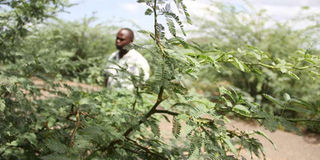Invasive species put a damper on use of irrigation in arid areas

A Mathenge plant in the semi-arid Marigat area, in Baringo County. The efforts to introduce irrigation in the arid and semi-arid lands in Kenya are being hindered by proliferation of invasive plants such as Ipomea and Mathenge. FILE |
What you need to know:
High levels of poverty also present a big challenge to the exploitation of the productive potential of the ASALs.
This is besides other threats such as population growth, land degradation and climate change that face Kenya’s ASAL regions.
The arid and semi-arid areas in Kenya face serious threats from invasive species, which hinder the productive potential that may arise from wide scale adoption of irrigation.
This is according to Ministry of Agriculture’s deputy director, range management division, Mr Ernest Mbogo, who says that efforts to introduce irrigation in the arid and semi-arid lands (ASALs) are hampered by proliferation of invasive plants such as Ipomea and Mathenge (invasive shrubs).
High levels of poverty among households, who are unable to sustain the irrigation systems, also present a big challenge to the exploitation of the productive potential of the ASALs.
COLONISE AREAS
“Due to the soil disturbance and removal of indigenous vegetation, there is tendency for invasive plant species such as Mathenge and Ipomea to colonise the affected areas. Field observations indicate a close relationship between irrigation/crop farming and invasion of Mathenge with cases in areas of Bura, Perkerra, Garissa, Garbatula and others,” Mr Mbogo said.
Despite increased focus on introducing practices such as irrigation to raise the productivity of rangelands in Kenya, irrigation remains capital intensive and resource poor farmers are unable sustain the systems on their own.
This is besides other threats such as population growth, high levels of poverty, land degradation, recurrent drought, loss of rivers and wetlands, declining wildlife and climate change that face Kenya’s ASAL regions.
SEMI-ARIDITY
Mr Mbogo was speaking at a meeting between the Rangelands Association of Kenya, African conservation Centre, International Livestock Research Institute and the University of Nairobi’s Centre for Sustainable Drylands Ecosystems and Societies on exploiting the economic potential of ASAL areas in Kenya.
ASALs cover 84 per cent of Kenya’s landmass, with 70 per cent being arid (Northern Kenya) and 19 per cent being semi-arid spread all over the country.
Pockets of semi-aridity can also be found in high-rainfall areas. The ASALs host slightly more than one third of the total population of Kenya with about 14 million people.




